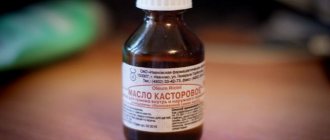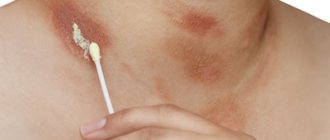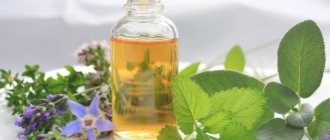A burn from hot vegetable oil is a serious injury that can cause serious harm to the victim. The boiling point of vegetable oils reaches 2000 C, which is twice as high as the boiling point of water. Such an injury is classified as thermal burns; when providing first aid, it is necessary to take into account the high heat transfer of vegetable oil and the concentration in the hearth. When hot oil hits the skin, it forms a thick, greasy film that limits the access of oxygen to the wound and maintains a high temperature. Incorrectly provided assistance can lead to serious consequences.
Classification of burns
First-degree hand burn
Typically, thermal burns are divided into four degrees, but a burn with vegetable oil has three:
- With a first-degree burn, the skin at the site of the injury becomes red and there is slight swelling. The injury is considered mild; it is enough to provide first aid at home; such a burn does not require special treatment.
- A second-degree burn with vegetable oil is characterized by the appearance of blisters filled with a clear liquid; they can be either small or large in size. The victim feels a burning sensation and severe pain; if the affected area of the skin is large, the person may receive a painful shock and lose consciousness. After providing first aid, the patient must be taken to the hospital.
- A third-degree burn includes injuries that affect not only the superficial layer of the epidermis, but penetrate into the subcutaneous fatty tissue. In this case, the nerve endings are affected and the blood vessels are torn. Due to severe damage, tissue necrosis begins, which is characterized by the formation of gray scabs and pus mixed with blood. In this case, treatment should only be carried out by a qualified specialist, and the assistance of a surgeon may also be required.
A fourth degree burn cannot be obtained at home; it involves damage and necrosis of muscle tissue and bones.
Recommendations for tanning without burns!
You need to be prepared for the hot sun!
Sunburn is much easier to prevent than to treat. Those who like to soak up the first rays of spring should not forget about the following rules for safe sun exposure and precautions:
- When starting sunbathing, do not stay in the sun for more than 15 minutes.
- Increase this time gradually, adding 5 minutes every day.
- If you have fair skin, you should spend slightly less time in the sun than recommended.
- The most even, beautiful and skin-friendly tan can be obtained under the diffused rays of the sun, in the shade of trees.
- Don't forget to moisturize and protect your face and body.
- Avoid being in the sun between 11 a.m. and 4 p.m. At this time, the possibility of getting a sunburn is greatest.
- If your skin does become red, avoid sun exposure until the condition improves.
- In case of serious damage to the skin, it is necessary to urgently seek medical help.
To moisturize and protect the skin from the scorching rays of the sun, it is recommended to use special cosmetics with SPF sun filters. However, not everyone knows that natural products are no less effective and more beneficial for skin health.
First aid for hot oil burns
First aid - cooling
First aid for a burn with boiling oil must be provided immediately; it is better if the victim is at home, then you can use home remedies. The algorithm of action depends on the severity of the injury, but the main thing is to provide assistance as quickly as possible. Under no circumstances should you self-administer any medications.
What to do if you are burned with vegetable oil?
- The burn site must be cooled; to do this, a stream of water at room temperature must be directed onto the affected skin, this will stop the inflammatory process of the skin. If the injury is serious, the process of destruction of tissue in the deep layers will be stopped, and the thermal burn will not be able to develop further. Ice should not be applied. With a severe burn, the victim may develop fever and chills, in which case he should be wrapped in a warm blanket.
- To prevent the surface of the wound from drying out and causing additional pain, it should be covered with a special pharmaceutical bandage that does not stick and is used for burns. If you don't have one, you can use regular cling film. When applying a bandage, you need to make sure that it is not pressed too tightly against the damaged tissue. These measures will protect the skin from drying out and maintain the necessary level of moisture necessary for the speedy healing of the wound. If there are no blisters after a burn, there is no need to apply a bandage.
- After all the manipulations, the victim must be taken to the clinic. A first-degree burn does not require further treatment; assistance provided at home will be sufficient. To make the lesion heal faster, it can be treated with a solution of manganese or furatsilin.
Before using medications, you should consult your doctor.
Choice of product
From the entire range of such medicines, we can name the following types of oils that can be used in the treatment of burns:
- Sea buckthorn. It has anti-inflammatory and healing effects. In addition, it can be used to prevent infection of damaged surfaces and eliminate swelling.
- Coconut. This remedy is very useful for sunburn. Thanks to it, recovery is accelerated, pain is reduced, and the risk of decay is reduced.
- Fir. It has disinfectant and anti-inflammatory properties.
Lavender. It is used for burns from boiling water, sunburn and thermal burns. It is distinguished by its healing properties.
- Creamy. This product is rarely used as a medicinal product. But if you combine this oil with other components, you can get good results.
- Linen. This remedy is characterized by the ability to relieve pain, relieve inflammation and heal damaged areas.
- Apricot. It is used mainly to improve the condition of the skin, but it also perfectly softens and nourishes damaged areas, while accelerating their regeneration.
- Peach. With its help, you can supply damaged skin with vitamins and speed up the healing process.
Separately, it is worth dwelling on the question of whether a burn can be anointed with sunflower oil. The fact is that it is always at hand, and it is precisely this that they most often try to use to provide first aid to the victim. And such actions, unfortunately, are usually wrong.
Sunflower oil can soften the skin, but it does not have a healing effect. In addition, it prevents air from contacting the damaged surface, interfering with healing. Therefore, this product should not be used when providing first aid. Its use may be allowed in the future, when the wound heals and it is necessary to stimulate peeling of the crust.
Incorrect and untimely use of oils can significantly harm the patient. Because of them, allergies or irritation may occur, and often due to lack of contact with air, the process of pus accumulation begins in the wound.
Therefore, when using this method of treatment, you need to be very careful and use oils only at the stage of healing of the burn.
Treatment of burns with vegetable oil
Healing medications - only as prescribed by a doctor.
Treatment of thermal burns comes down to eliminating symptoms and is comprehensive. The doctor determines how to treat the injury. As a rule, therapy consists of the following activities:
- The use of painkillers to relieve pain and reduce the sensitivity of receptors located in the subcutaneous layers. Analgesics should only be used for severe pain.
- Treating damaged skin with antiseptics is necessary for disinfection from microbes that easily penetrate open wounds. Pathogenic microflora can cause an inflammatory process, including the development of sepsis.
- Applying moisturizers to the affected areas of the skin will protect it from dryness and help the tissues recover faster.
- Taking anti-inflammatory drugs stops the inflammatory process, which can begin in an organism weakened by injury.
- The use of wound healing agents is permitted only as prescribed by a doctor. Do not use preparations containing oils; in case of an oil burn, they will only worsen the condition of the wound.
Contraindications and precautions
As with any natural product, a tolerance test should be performed before using natural oils to rule out the possibility of allergic reactions. To do this, take a drop of oil and apply it to your wrist or elbow. If after some time there is no discomfort, burning, redness or itching on the skin, the oil is suitable for use.
Natural products have different effects on the skin, each of them has its own contraindications and application features. Therefore, in addition to conducting a test for individual intolerance, you should consult a doctor before using oils for burns. When using, follow the rules, dosage and precautions specified in the manufacturer's instructions.
Tags:
tan oil burn first aid
Traditional medicine recipes
Cabbage leaf
To speed up the healing of wounds after a thermal burn with oil, you can use home remedies made from natural ingredients:
- To eliminate pain, it is recommended to use compresses made from pumpkin pulp or raw potatoes; to speed up tissue regeneration, you can add 1 tsp. honey The resulting mixture should be applied to the affected area of the skin, covered with a sterile napkin. The compress is kept for 3-4 hours, and the residue is removed with a soft, clean cloth.
- For speedy healing, oak bark is used. It contains tannins that promote tissue restoration, and the decoction is used for lotions. It is prepared like this: 1 tbsp. l. bark, pour 100 ml of boiling water and cook over low heat for 10 minutes. Apply after the decoction has cooled to room temperature.
- Aloe leaf is used as an antiseptic to avoid inflammation in the wound; the plant is applied to the affected area and secured with a bandage. First, the sheet must be thoroughly washed and cut lengthwise, and applied to the hearth with a cut.
- A mixture of eggs and rich sour cream will moisturize the skin and accelerate tissue regeneration. To prepare, take 1 yolk, 2 tbsp. l. sour cream and 1 tsp. olive oil, mix everything thoroughly and lubricate the wounds. There is no need to cover the top with anything; when the mixture is well absorbed, the residue should be removed with a sterile napkin.
- Cabbage leaf is known for its healing properties, it soothes pain, and in combination with egg whites accelerates the restoration of the skin. Pass the juicy leaves of white cabbage through a meat grinder and combine the pulp with fresh egg white. Apply the prepared mixture to the wound and keep it for 24 hours, constantly renewing the bandage. After the procedure, the result will be obvious.
- You can use streptocide powder as an antiseptic and wound-healing agent; if you don’t have it, take 10 tablets and grind them in a mortar. Stir the resulting powder in 100 ml of vegetable oil, preferably olive or sea buckthorn; these oils themselves have a medicinal effect. The finished mixture must be heated in a steam bath for 30 minutes and then cooled. The medicine is ready, it is recommended to lubricate the affected areas every 2-3 hours. After 2-3 days the wound will begin to heal.
All traditional medicine recipes are auxiliary and should be used in parallel with drug therapy. We must not forget about individual intolerance to some components, so before use it is recommended to test for an allergic reaction of the body. If suppuration begins in the wound, you need to urgently contact the clinic.
When is use justified?
It should be said right away that the use of this remedy for burns is still possible. This applies to wounds that are already healing. In this case, treatment with vegetable oil speeds up the healing process; in addition, the forming crust will come off the wounded surface faster, and new skin will appear in return. This remedy also has an analgesic effect.
That is why there are many traditional medicine recipes that contain essential oils aimed at speedy healing of injuries of this type. A specialist can recommend their use, but you need to clearly know what concentration the product should be in and how long it can be kept on the skin.
In addition, it is necessary to take into account the contraindications that exist in each specific case.
To figure out whether it is possible to anoint the skin with oil during a burn, you should understand the peculiarities of the action of this product on damaged surfaces. It consists of the following two features:
- the formation of a protective film that prevents infection from entering the wound;
- reducing the risk of edema.
These two features are inherent in any type of oil. Some varieties also have their own characteristics, for example, providing an anti-inflammatory effect, softening injured areas, and disinfection.
Contraindications to the use of essential oils for burns
The issue of anti-burn measures, as already noted, is very serious and therefore essential oils cannot be used in the following situations when:
- Large areas of skin (larger than the palm) were burned.
- The mucous surfaces, face, joints, and genitals are affected.
- The degree of burn exceeds 1 degree.
- The burn was caused by electrical exposure.
- When large blisters form that have changed color (black or white).
- With suppuration of the burn surface.
You should also pay attention to the fact that allergic reactions are possible from essential oil used for burns. If after a long time the burning sensation from the essential oil does not go away, it is better to stop using it, wash the burn area with cold water and soap and consult a doctor.
Degrees
Considering this damage specifically, it can be argued that the fourth degree practically does not occur. Detailed classification:
- First, the epidermis layer is damaged only on the upper contours; slight redness is possible, which goes away in 3-4 days without medical intervention;
- The second is that the pain becomes more pronounced, bubble formations appear, and then they fill with exudate. It is strictly forbidden to burst bubbles, as this can lead to an inflammatory process.
- Third, not only the skin dies, but also the lower tissue, and a number of complications and infection are often observed.
- The fourth is not typical for burns with hot oil. Accompanied by charring of muscle tissue, tendons and nerve fibers.
Regenerating properties of oils
Vegetable oils are, in fact, concentrates of beneficial bioactive substances of the plants from which they are produced. In the process of evolution, they had to develop and improve mechanisms of resistance to dangerous environmental factors, synthesize complex chemical compounds with unique restorative and protective algorithms. Each base oil consists mainly of a variety of fatty acids that have valuable properties:
- anti-inflammatory;
- anesthetic;
- bactericidal, antiviral, antimicrobial;
- immunostimulating;
- regenerating.
Essential oils, the formulas of which are saturated with terpenes, alcohols, and organic acids, are even more active than base oils and have a strong stimulating effect. First of all, esters of lavender, tea tree, chamomile, myrrh, eucalyptus, etc. are effective in tissue regeneration.
Features of first aid
If boiling oil comes into contact with your skin, it is important to immediately provide assistance:
- If a limb is injured, then the arm or leg should be placed under a stream of cool, but not icy, water. When another area is exposed, it is also washed for 20 minutes to relieve pain. You cannot always use ice, so avoid this measure. In case of a 3rd degree injury, it is not advisable to expose the burned area to the stream, so the limb is immersed in a container of cool water.
- If clothing is stuck to your skin, you should not tear it off. Carefully cut the tissue around the area exposed to the vegetable oil and leave it to the medical professional.
- After rinsing with water, do not wipe the injured area with cotton wool or terry towels, otherwise lint will worsen the situation. If there is a need to remove excess moisture, use gauze.
- After an oil burn, first aid should include applying a sterile drape. Pre-treat the area near the edges with an antiseptic to avoid infections. This step is required only when the oil burn is accompanied by the formation of blisters, and in case of redness, you can get by with the application of special aerosols.
- If a child is injured, parents may make the mistake of completely submerging the child in a bathtub of cold water. The risk of hypothermia is too great, so limit yourself to washing the limb that has been exposed to boiling sunflower oil.
How to treat further if you are burned
In most cases, burns are treated at home. To ensure that the injury heals faster and serious scars do not form, it is recommended to follow the recommendations of the attending physician, regularly change the bandages, avoid mechanical damage and lubricate the area with medications.
As a rule, the recovery time for first-degree burns does not exceed one week. If small blisters appear, treatment lasts for two weeks.
General recommendations
Each injury received can undermine a person’s health. By adhering to some rules, you can avoid complications and speed up recovery time:
- Drinking plenty of fluids promotes rapid skin regeneration.
- Balanced diet. During the healing period, it is recommended to give preference to foods of plant origin. Add unprocessed oil to vegetable salads. These products will increase skin elasticity.
- Alcohol consumption slows down the regeneration of soft tissues.
- You should not refuse to take a shower and protect your injury from getting wet. Microbes are washed off under running water. After showering, gently pat the sore skin dry.
- Protect the wound when working with contaminants.
If the wound is large, doctors often recommend taking a vitamin complex.
What to apply from medicines
There is a large selection of medications in pharmacies and choosing a remedy can be difficult. However, we can highlight several remedies that have proven themselves and have proven effective over many years of use by victims:
- Panthenol spray - this drug starts metabolic processes in skin cells and promotes rapid healing. The main active ingredient is dexpanthenol. It has an anti-inflammatory effect. Treatment is carried out 3 times a day.
- Olazol is made from several components - benzocaine (painkiller), sea buckthorn oil (softening and regenerating), chloramphenicol (antibiotic), and boric acid (antiseptic). It relieves pain and prevents infection.
- Solcoseryl starts the regeneration process, activating the processes of cell division and collagen production.
- Bepanten-plus will prevent the entry of pathogenic microbes and speed up healing.
- Lioxazine gel helps improve microcirculation, relieves vascular spasm, and has an analgesic and antimicrobial component.
- Guardian, Rescuer, Healer , etc. Such medicines contain natural ingredients that help to quickly cure first-degree burns.
- Stelanine is an ointment for burns. It starts the regeneration process. Iodine is added to it as a bactericidal component. The medicine is prescribed to patients for the treatment of burns of the first or second degree of complexity.











